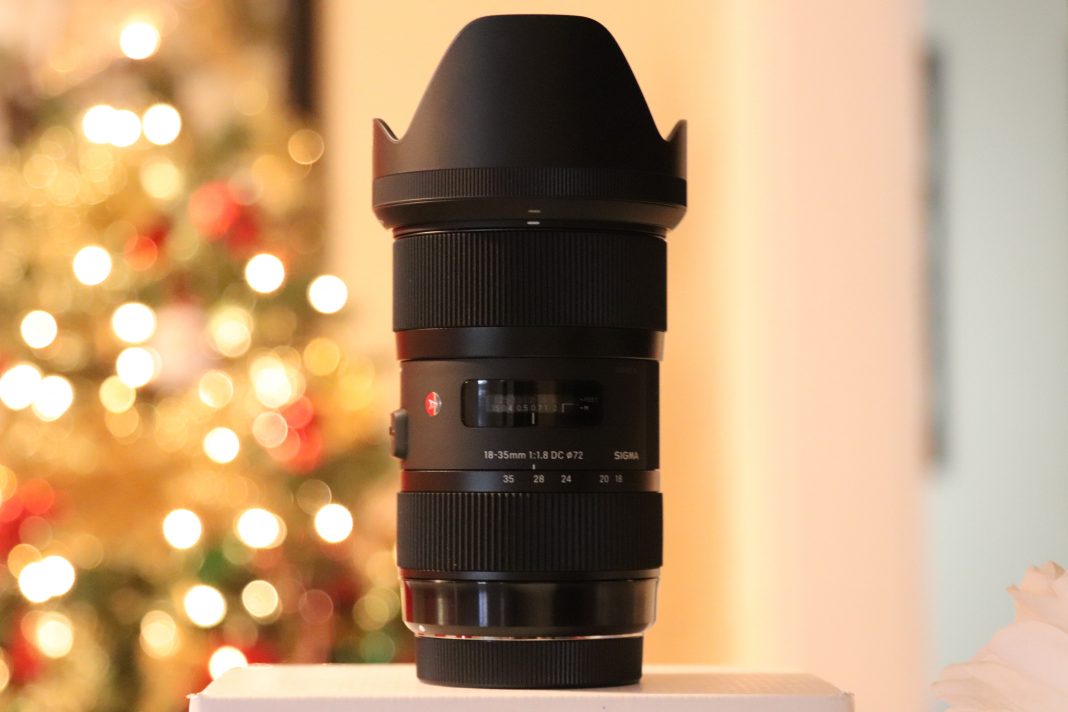Being an owner of a crop sensor camera can be rather challenging at times when it comes to narrowing down the right choice for a lens, we know the slight challenge of using a full frame lenses and having to frame our shot just right. Whether you’re capturing photos or videos, we all would love to have that one universal lens that we could use that would just about do it all and help us achieve that perfect shot. I would say look no further when it comes to the Sigma 18-35mm F1.8 DC HSM Art lens, which has coined the reputation of being the “First and fastest of its kind”. Meaning being the first wide angle zoom lens to have a large aperture of 1.8 while providing a fast, continuous, and bright auto-focus as well as producing sharp images. This lens is specifically designed for crop sensor (APS-C sized) cameras and provides a focal length of 18-35mm which equates to 28.8-56mm, which I used for my Canon T7I. This lens is best suited for photography, close-up shots, landscapes, low light photography, and works great for video production.
So one might ask, “Why review a lens 5 years after its initial release”? Well to answer that question I’m relatively new in the field of videography and photography so I’m still discovering what’s out there in the world of camera hardware. Upon discovering that there was a lens specifically designed for crop sensor cameras that provided outstanding photography and video quality, I wanted to put it the test. Does this lens truly live up to its reputation? Let’s talk about it.
Specs and Details (Courtesy of Sigma.com)
Lens Construction-17 elements in 12 groups
Angle of View (SD1)- 76.50-44.20
Number of Diaphragm Blades- 9
Minimum Focusing Distance- 28cm/11.0 in
Filter Size (mm) -72mm
Maximum Magnifications- 1:4.3
Dimensions (Diameter x Length) 78mm x 121.0mm x 3.1in x 4.8 in
Maximum Apeture- F1.8
Minimum Apeture- F16
Focal Length 18-35mm
Price- varies between $600-$700
Design and Build Quality
 The sigma 18-35mm F1.8 is made out of metal and weighs 28.6oz (which is about 1.78lbs), it gives off a simplistic yet sleek and stylish look which nicely coordinates with most cameras due to the black on black finish. I find that the weight of the camera felt very comfortable as far as using it for handheld videography but it is quite a large lens yet lightweight. When I added my battery pack I instantly noticed the weight increase which isn’t necessarily a bad thing if you don’t mind the extra weight but it’s something to keep in mind if you’re using a gimbal, steadicam, or a slider since those pieces of equipment normally have weight limits. It has one button on the lens that you can switch between auto to manual mode and also turning on the focal and zoom rings feels smoothly done with a turning motion on the ridged rubber grip and doesn’t feel stiff when you’re adjust the manual focus. For example, when using the Canon L series lenses if you attempt to go past the minimum or maximum focal range the turning motion would stop, but if you were to do this with the Sigma 18-35mm lens you can continue to turning the focal ring past its minimum or maximum focal length. This lens also has a glass display indicating the focal length range which comes to use.
The sigma 18-35mm F1.8 is made out of metal and weighs 28.6oz (which is about 1.78lbs), it gives off a simplistic yet sleek and stylish look which nicely coordinates with most cameras due to the black on black finish. I find that the weight of the camera felt very comfortable as far as using it for handheld videography but it is quite a large lens yet lightweight. When I added my battery pack I instantly noticed the weight increase which isn’t necessarily a bad thing if you don’t mind the extra weight but it’s something to keep in mind if you’re using a gimbal, steadicam, or a slider since those pieces of equipment normally have weight limits. It has one button on the lens that you can switch between auto to manual mode and also turning on the focal and zoom rings feels smoothly done with a turning motion on the ridged rubber grip and doesn’t feel stiff when you’re adjust the manual focus. For example, when using the Canon L series lenses if you attempt to go past the minimum or maximum focal range the turning motion would stop, but if you were to do this with the Sigma 18-35mm lens you can continue to turning the focal ring past its minimum or maximum focal length. This lens also has a glass display indicating the focal length range which comes to use.
Image Quality
Most of the images that I captured with the Sigma 18-35mm lens produced beautiful results, even when the lens shutter was fully opened, the images were extremely sharp, clear, and crisp. When it came to close up shots at 1.8 the images were even more sharp and produce an amazing bokeh but my only issue was that when the lens is on auto focus mode it wouldn’t focus on the subject the fully, which happened very rarely. After conducting further research, I gathered that other individuals that used this lens also experienced issues with the auto focus for this lens when it came to micro adjustments which is why Sigma has the USB dock available when you run into these type of nuances.
The Sigma USB Dock allows you to update your firmware and calibrate and adjust your focus settings via the Sigma Optimization Pro Software. While this is a good tool to have if you own this lens, it could also be an unnecessary expense to some with a price of $60. In a worst case scenario you could always use manual focus to get that razor sharp image. After using this lens at a sporting event, the images were sharp at a high shutter speed capturing the fast movement phenomenally as if it was still photography. Even doing some night photography this lens produced great results for low light situations of course using F1.8.



Pros
Let’s explore the pros of the Sigma 18-35mm F1.8 shall we, for starters it’s a lens that specifically made for crop sensor cameras that give you the results of a full frame camera that a lot of other lenses cannot do. This lens truly does live up to the reputation of being the “First and fastest of its kind”. I would highly recommend this lens for those who are upgrading their lenses from a standard kit lens and want to take a step towards owning a piece of professional glass to improve the photo and video quality. The auto-focus worked nicely in most situations and the motor is quieter when operating compared to several other lenses that I used in the past.

Now let’s discuss where this lens falls short, the negative aspect. For starters, the Sigma 18-35mm F1.8 lens does not have an Image Stabilization feature which can possibly be a deal breaker for some individuals especially beginner videographers. When it comes to filming handheld without the use of any stabilizing equipment, I tend to rely on Image Stabilization to help me achieve that smooth, precise shot. Next, the Sigma USB dock, although its great to update the firmware among with adjusting other settings for the lens, having to calibrate the auto focus particularly for micro shots may be an unnecessary expense just to own the USB Dock. Especially when the lens itself already cost upward to $700 at the time of this review.
Also, this is a crop sensor lens designed specifically for APS-C sensor camera and it is not recommended for full frame cameras unless it has a crop sensor mode, most cameras that are high end are either mirrorless or full frame which camera enthusiasts or professionals upgrade to.
Verdict
Overall, I feel that this lens is a top choice for an any photographer or videographer to include this lens as a part of their camera arsenal or as a choice for beginner videographers or photographers as a first upgrade from their initial kit lens. This is a great all-around lens for producing phenomenal results and acting as a prime lens on various focal lengths. The only downside that I see with this lens is that it is not equipped with Image Stabilization and basically purchasing the Sigma USB dock to calibrate the auto-focus is pretty much a requirement and an additional expense. Other than that, this lens is a must have in your collection to help you with taking your photography and videography to the next level.




